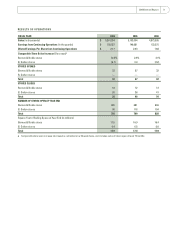Barnes and Noble 2006 Annual Report Download - page 21
Download and view the complete annual report
Please find page 21 of the 2006 Barnes and Noble annual report below. You can navigate through the pages in the report by either clicking on the pages listed below, or by using the keyword search tool below to find specific information within the annual report.
represents the period of time that stock option awards
granted are expected to be outstanding. The assumptions
used in calculating the fair value of share-based payment
awards represent management’s best estimates, but these
estimates involve inherent uncertainties and the applica-
tion of management’s judgment. As a result, if factors
change and the Company uses diff erent assumptions,
stock-based compensation expense could be materi-
ally diff erent in the future. In addition, the Company is
required to estimate the expected forfeiture rate, and only
recognize expense for those shares expected to vest. If the
Company’s actual forfeiture rate is materially diff erent
from its estimate, the stock-based compensation expense
could be signifi cantly diff erent from what the Company
has recorded in the current period. See Note to the
consolidated fi nancial statements for a further discussion
on stock-based compensation.
Other Long-Lived Assets
The Company’s other long-lived assets include property
and equipment and amortizable intangibles. At February
, , the Company had . million of property
and equipment, net of accumulated depreciation, and
. million of amortizable intangible assets, net of
amortization, accounting for approximately . of the
Company’s total assets. The Company reviews its long-
lived assets for impairment whenever events or changes
in circumstances indicate that the carrying amount of an
asset may not be recoverable in accordance with SFAS
No. , “Accounting for the Impairment or Disposal
of Long-Lived Assets”. The Company evaluates long-
lived assets for impairment at the individual store level,
which is the lowest level at which individual cash fl ows
can be identifi ed. When evaluating long-lived assets for
potential impairment, the Company will fi rst compare
the carrying amount of the assets to the individual
store’s estimated future undiscounted cash fl ows. If the
estimated future cash fl ows are less than the carrying
amount of the assets, an impairment loss calculation is
prepared. The impairment loss calculation compares the
carrying amount of the assets to the individual store’s
fair value based on its estimated discounted future cash
fl ows. If required, an impairment loss is recorded for
that portion of the asset’s carrying value in excess of fair
value. Impairment losses included in selling and admin-
istrative expenses totaled . million, . million and
. million in fi scal , and , respectively
and are related to individual store locations.
Goodwill and Unamortizable Intangible Assets
At February , , the Company had . million of
goodwill and . million of unamortizable intangible
assets (i.e. those with an indefi nite useful life), account-
ing for approximately . of the Company’s total
assets. SFAS No. , “Goodwill and Other Intangible
Assets”, requires that goodwill and other unamortizable
intangible assets no longer be amortized, but instead be
tested for impairment at least annually or earlier if there
are impairment indicators. The Company performs a
two-step process for impairment testing of goodwill
as required by SFAS No. . The fi rst step of this test,
used to identify potential impairment, compares the
estimated fair value of a reporting unit with its carrying
amount. The second step (if necessary) measures the
amount of the impairment. The Company completed its
annual impairment test on the goodwill in November
and deemed that no impairment charge was neces-
sary. The Company has noted no subsequent indicators
of impairment. The Company also completed its annual
impairment tests for unamortizable intangible assets by
comparing the estimated fair value to the carrying value
of such assets and determined that no impairment was
necessary. Changes in market conditions, among other
factors, could have a material impact on these estimates.
Gift Cards
Revenue associated with gift cards is deferred until
redemption of the gift card. The Company estimates the
portion of the gift card liability for which the likelihood
of redemption is remote and records this amount in
income on a straight-line basis over a -month period
beginning in the th month after the month the gift
card was originally sold based upon the Company’s
historical redemption patterns. If actual redemption
patterns vary from the Company’s estimates, actual gift
card breakage may diff er from the amounts recorded.
Newly Issued Accounting Pronouncements
In July , the Financial Accounting Standards Board
(FASB) issued FASB Interpretation No. , “Accounting
for Uncertainty in Income Taxes-an interpretation
of FASB Statement No. ” (FIN ). FIN clari-
fi es the accounting for income taxes by prescribing
the minimum recognition threshold a tax position is
required to meet before being recognized in the fi nan-
cial statements. Additionally, FIN provides guidance
on derecognition, classifi cation, interest, penalties,
accounting in interim periods and disclosure related
2006 Annual Report 19
























